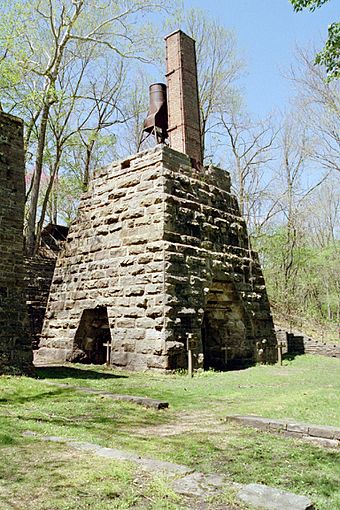Maramec Spring facts for kids
Quick facts for kids Maramec Spring |
|
|---|---|

The spring discharges below an overhanging bluff of Gasconade Dolomite.
|
|
| Country | United States |
| State | Missouri |
| Region | Ozark Plateau |
| County | Phelps |
| Physical characteristics | |
| Main source | Dry Fork watershed Salem Plateau, Ozark Plateau, Missouri 773.97 ft (235.91 m)USGS |
| River mouth | Meramec River near St. James, Phelps County, Ozark Plateau, Missouri 37°57′20″N 91°31′57″W / 37.95556°N 91.53250°W |
| Length | 0.87 mi (1.40 km) |
| Basin features | |
| U.S. NNL | Designated: 1971 |
|
Maramec Iron Works District
|
|

The remains of an iron furnace of the Maramec Iron Works which used hydropower from the spring
|
|
| Nearest city | St. James, Missouri |
| Area | 0 acres (0 ha) |
| Built | 1826 |
| NRHP reference No. | 69000122 |
| Added to NRHP | April 16, 1969 |

Maramec Spring is a huge natural spring located in Missouri, near the town of St. James. It's found in the beautiful Ozarks region. This spring is the fifth largest in Missouri, releasing about 153 cubic feet (4.3 cubic meters) of water every second! That's a lot of water!
The area around the spring is known as a karst region. This means the ground is made of limestone and dolomite, which can dissolve easily. This creates many caves and springs underground.
The James Foundation owns Maramec Spring and about 1,800 acres (7.3 square kilometers) of land around it. They keep it as a public park for everyone to enjoy. The Missouri Department of Conservation also runs a trout hatchery here. They raise fish and manage fishing in the spring.
You can still see the old buildings of the Maramec Iron Works at the site. This factory used the spring's powerful water flow to run its machines. Because of its importance, Maramec Spring was named a National Natural Landmark in 1971.
Contents
What Makes Maramec Spring Special?
Maramec Spring lets out about 100 million gallons (363 million liters) of water every day. That's enough to fill many swimming pools!
The James Foundation has a museum at the park. It teaches visitors about the spring's natural history and the story of the old iron works. There's also another museum that shows off old farming tools used in the area long ago.
You can take a scenic drive through the park. It gives you a peek into what life was like when the iron works were busy. The drive leads to a great view of the park, an old cemetery where workers were buried, and the spot where iron ore was dug up. The park also has lots of picnic spots and shelters for events.
History of the Maramec Iron Works
Right next to the spring are the ruins of the Maramec Iron Works. This was the first successful iron factory west of the Mississippi River in the United States. It made iron from 1827 to 1891.
During the U.S. Civil War, the factory made iron for cannonballs. It also helped build gunships for James B. Eads in St. Louis. These ships were important for the war. The iron works used the strong flow of water from the spring to power its machines. They processed high-quality iron ore, called hematite, which was dug from a nearby pit. The Maramec Iron Works District was added to the National Register of Historic Places in 1969.
Every October, the James Foundation holds an event called "Old Iron Works Days." It usually happens on the second or third weekend of the month. This event features arts, crafts, food, and shows that let you experience what life was like when the iron works were running.
Fun Things to Do at Maramec Spring Park
Maramec Spring Park is one of four special trout parks in Missouri. This means it's a great place for fishing!
Fishing for Trout
You can fish for trout almost all year round. The main fishing season starts on March 1st and goes until early October. During the winter months, there's a "catch and release" season, where you catch fish but then let them go. The park's hatchery raises about 100,000 trout each year. They restock the stream every day during the fishing season, so there are always plenty of fish!
Camping and Picnics
The park has 58 campsites if you want to stay overnight. Ten of these sites have electric hook-ups for your convenience. There are also many picnic areas, six picnic shelters you can reserve for groups, and several playgrounds for kids to enjoy.

